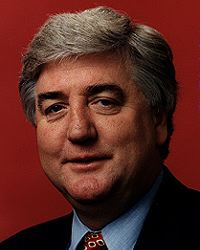Related Research Articles

Vincent Clair Gair was an Australian politician. He served as Premier of Queensland from 1952 until 1957, when his stormy relations with the trade union movement saw him expelled from the Labor Party. He was elected to the Australian Senate and led the Democratic Labor Party from 1965 to 1973. In 1974 he was appointed Australian Ambassador to Ireland by the Whitlam government, which caused his expulsion from the DLP.

The Australian Council of Trade Unions (ACTU), originally the Australasian Council of Trade Unions, is the largest peak body representing workers in Australia. It is a national trade union centre of 46 affiliated unions and eight trades and labour councils. The ACTU is a member of the International Trade Union Confederation.

William Guthrie Spence, was an Australian trade union leader and politician, played a leading role in the formation of both Australia's largest union, the Australian Workers' Union, and the Australian Labor Party.
The Australian Workers' Union (AWU) is one of Australia's largest and oldest trade unions. It traces its origins to unions founded in the pastoral and mining industries in the late 1880s and it currently has approximately 80,000 members. It has exercised an outsized influence on the Australian Trade Union movement and on the Australian Labor Party throughout its history.

The Amalgamated Engineering Union (AEU), originally known as the Amalgamated Society of Engineers, was an Australian trade union which existed between 1852 and 1973. It represented engineers, as well as some other metal trades workers.

Michael George Forshaw is an Australian politician who served as a member of the Australian Senate for the state of New South Wales from May 1994 to June 2011, representing the Australian Labor Party.

John Barkell Holman was an Australian politician who served in the Western Australian Legislative Assembly from 1901 to 1921 and 1923 to 1925.

The Amalgamated Engineering Union (AEU) was a major British trade union. It merged with the Electrical, Electronic, Telecommunications and Plumbing Union to form the Amalgamated Engineering and Electrical Union in 1992.

Edward Grayndler was an Australian trade unionist and politician. He served as general secretary of the Australian Workers' Union (AWU) from 1912 to 1941, the longest term in the union's history.

The Confederation of Shipbuilding and Engineering Unions (CSEU), often known as the Confed is a trade union confederation in the United Kingdom.

Donald Macdonell was a politician, trade unionist and shearer in New South Wales, Australia.

The Federated Ironworkers' Association of Australia (FIA) was an Australian trade union which existed between 1911 and 1991. It represented labourers and semi-skilled workers employed in the steel industry and ironworking, and later also the chemical industry.
Railway Unions in Australia organised labour of railway employees in Australia operated under federal and State awards - this is a partial list of known unions. Many of the unions amalgamated over time, creating a complex trail of ancestry for some of the later unions.
The Amalgamated Society of Engineers (ASE) was a major British trade union, representing factory workers and mechanics.
The Federated Moulders' (Metals) Union of Australia (FMMUA) was an Australian trade union which existed between 1899 and 1983. It represented moulders – skilled tradesmen who fabricated the moulds for casting metal products in foundries. In spite of only organising within a single skilled occupation, which kept total membership low, the vital position of moulders in major industries such as mining, manufacturing and the railways, ensured that the union remained industrially powerful with a reputation for being highly militant.
Paul Joseph Hugh McDermott is an Australian politician who was elected to the New South Wales Legislative Assembly as the State Member for Prospect for the Labor Party at the 2015 New South Wales state election. Prior to entering Parliament, he had a career as an international lawyer and university academic.
Daniel Cameron Dalgleish was a Scottish-born Australian politician.

Fallon House is a heritage-listed trade union office at 1 Maryborough Street, Bundaberg Central, Bundaberg, Bundaberg Region, Queensland, Australia. It was designed by David Ballinger Goodsir and Harold James Carlyle and built in 1953 by Llewellyn Herbert Edwards. It was added to the Queensland Heritage Register on 7 December 2012.
William Hegney was an Australian politician who was a Labor Party member of the Legislative Assembly of Western Australia from 1939 to 1968. He served as a minister in the government of Albert Hawke.
Cecil Thompson "Charlie" Oliver AM was an Australian trade unionist and politician. He was a Labor Party member of the Legislative Assembly of Western Australia from 1948 to 1951, representing the seat of Boulder, and was later prominent in the labour movement in New South Wales as the state secretary (1951–1978) and state president (1980–1985) of the Australian Workers' Union.
References
- 1 2 3 Australasian Society of Engineers (ii) (1938 - 1991), Australian Trade Union Archives. Retrieved 8 January 2017.
- ↑ Saunders, Malcolm; Lloyd, Neil (November 2011). "Arbitration or Collaboration? The case of the Australasian society of engineers in South Australia 1904-68". Labour History. 101: 123–144. doi:10.5263/labourhistory.101.0123.
- ↑ "TWO UNIONS WARNED", The Courier-Mail , 1 February 1938.
- ↑ "RE-REGISTRATION FOR ENGINEERS.", The Sydney Morning Herald, 10 August 1938.